Instructions for choosing a variety and planting Dutch onions for the winter
Planting onions in winter helps save time and effort during the spring work on a summer cottage. New winter varieties from both Russian and foreign breeders are constantly appearing. Navigating this diversity is becoming increasingly difficult. Today we will reveal the secrets of planting Dutch onions for the winter.
Is it possible to plant Dutch onions before winter?
Dutch sharp and semi-sharp varieties are excellent for planting before winter throughout Russia. They practically do not bolt, are frost-resistant and can withstand soil temperatures down to -15°C.
At lower temperatures, thick snow cover can protect them. However, you should not plant southern sweet onion varieties before winter - they will not tolerate cold weather.
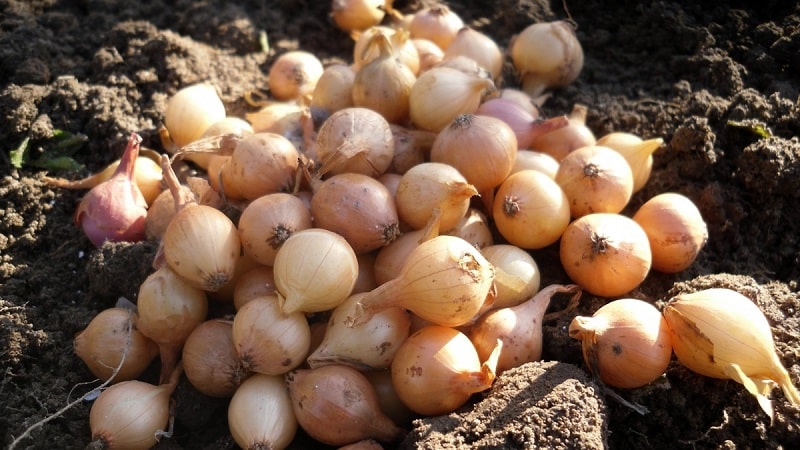
When to plant winter onions
Focus on the climate norms of the region. Plant onions when the daytime temperature drops to +5...+7°C and stays at this level for at least a week.
When planted in winter, it takes three weeks for sets to take root. If the onion does not have time to take root before the onset of frost, it will either not sprout in the spring or will go to pieces.
The best predecessors according to the rules of crop rotation
So that the bulbs are not susceptible to disease during growth, and also received all the necessary microelements for nutrition, observe crop rotation.
Excellent predecessors will be green manure and grains (except oats), cabbage, tomatoes, cucumbers, salad crops, pumpkin, beans, peas, beets.
Varieties of Dutch selection
More than two dozen winter varieties from Holland are presented on the Russian market. Let us list those that have proven themselves to be excellent during winter planting in various regions of Russia and are therefore most popular among summer residents.
Radar
Early maturing hybrid, zoned throughout the Russian Federation. It tolerates temperatures down to -15°C, with large amounts of snow it can withstand temperatures down to -25°C, and is resistant to bolting. The bulb is golden yellow in color, round in shape, high density.
Large - with good care it grows weighing up to 150-300 g. The harvest is perfectly stored. Radar has high resistance to diseases and pests. When planted in winter, the heads grow by the beginning of June.
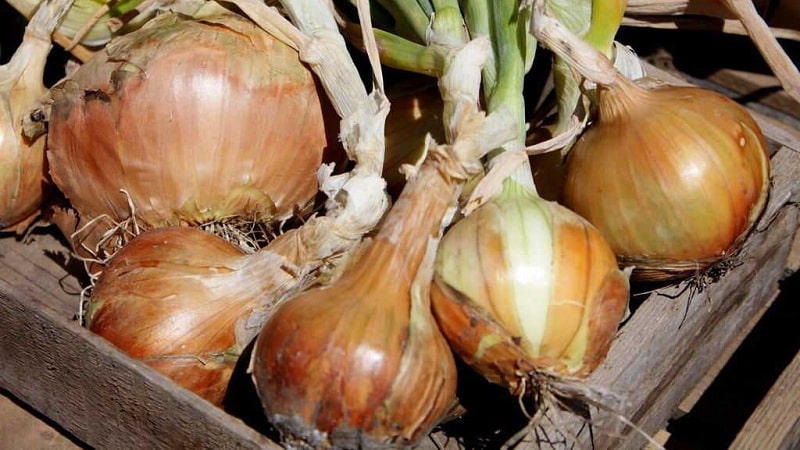
Shakespeare
This is one of the most reliable semi-sharp winter varieties. Shakespeare tolerates temperatures down to -18°C even without snow cover.
Early ripening - 75 days pass from germination to ripening. The color of the scales is brown. The flesh of the bulbs is white and juicy. The heads are round in shape, weighing about 100 g. The variety is resistant to diseases.
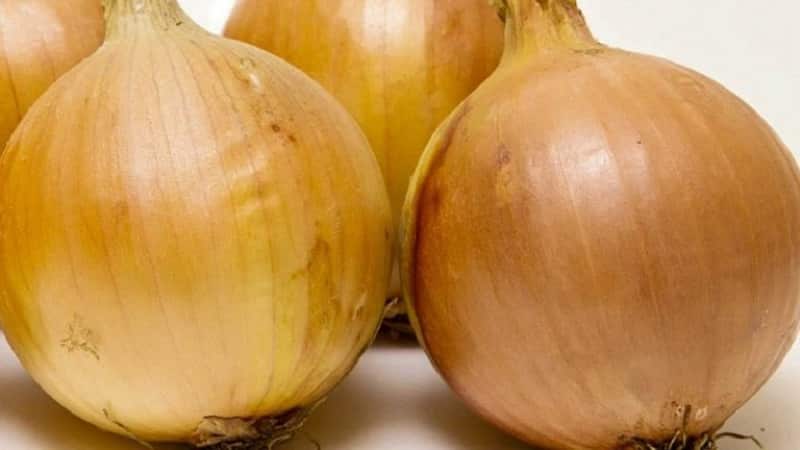
Centurion
Early ripening hybrid has a moderately spicy taste. The shape of the bulbs is slightly elongated, the flesh is white, the husk is golden yellow. The head grows weighing from 100 to 150 g.
Centurion - an improved version of the popular German variety Stuttgarten Riesen. Valued for its resistance to excess humidity, dry weather, and large temperature changes. This variety is grown in all regions of Russia, from the south to the Far East. At low temperatures, the crop is stored for 8 months.
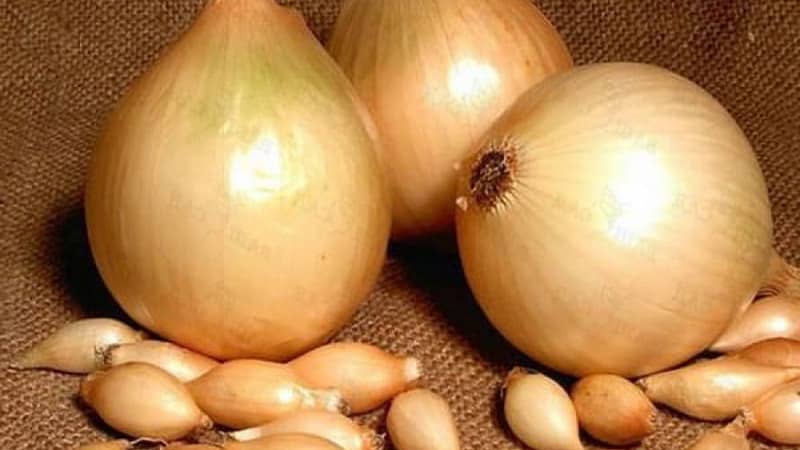
Hercules
High-yielding hybrid Hercules early ripening. The heads weigh 120-160 g and reach maturity 70-80 days after the start of the growing season. The bulbs are oval-oblong, golden yellow in color. The pulp is juicy, white; the taste is spicy. Advantages: undemanding to soil, frost resistance, excellent keeping quality. It can be stored for up to 9-10 months.
The variety has high immunity to many diseases and viruses. It is recommended for cultivation in the central part of Russia, but due to its unpretentiousness it is planted almost everywhere.
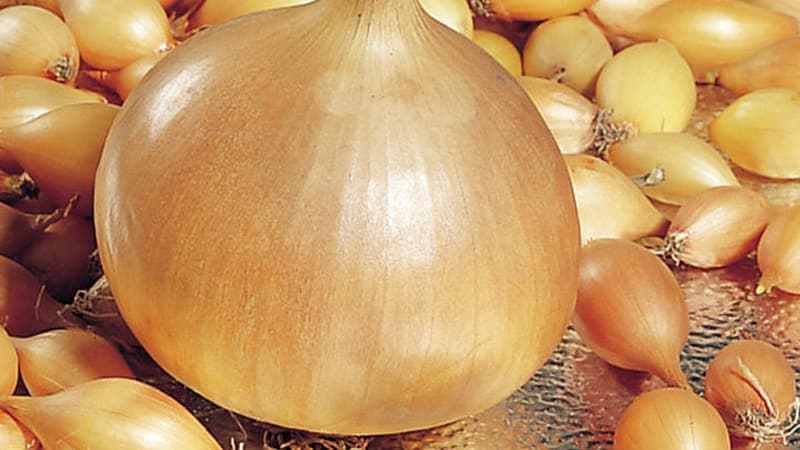
Sturon
The mid-season onion variety ripens in 110-120 days, is resistant to bolting, and cold-resistant. Very productive - distinguished by large bulbs up to 180-210 g. They have an ellipsoidal shape, the husk is golden in color. The onion is dense and juicy. Can be stored for up to 9 months. Resistant to diseases, does not form an arrow.
Sturon recommended for cultivation in temperate and southern latitudes. The variety is popular in many areas. The Central and West Siberian regions are considered favorable in terms of climate and soil.
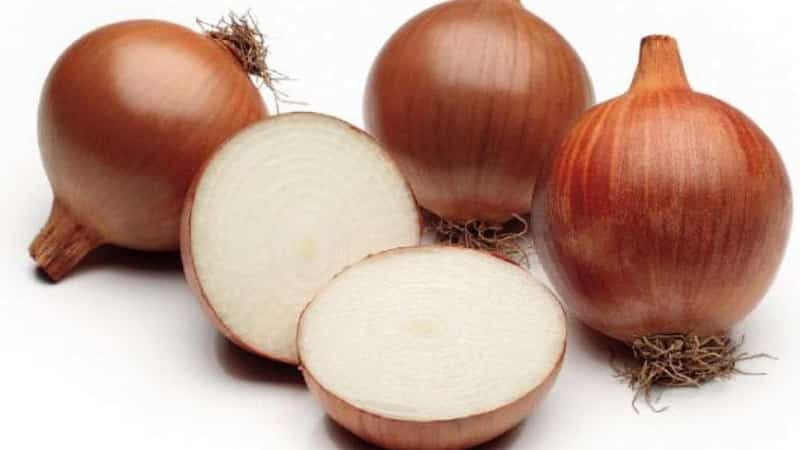
Troy
Undemanding early ripening hybrid. The harvest is obtained 75-80 days after the feather appears. Onion with a pungent taste, white flesh. Tolerates frosts well and does not bolt. The heads are round, with a dense golden husk. Troy has high keeping quality. It has good immunity - resistant to diseases and pests.
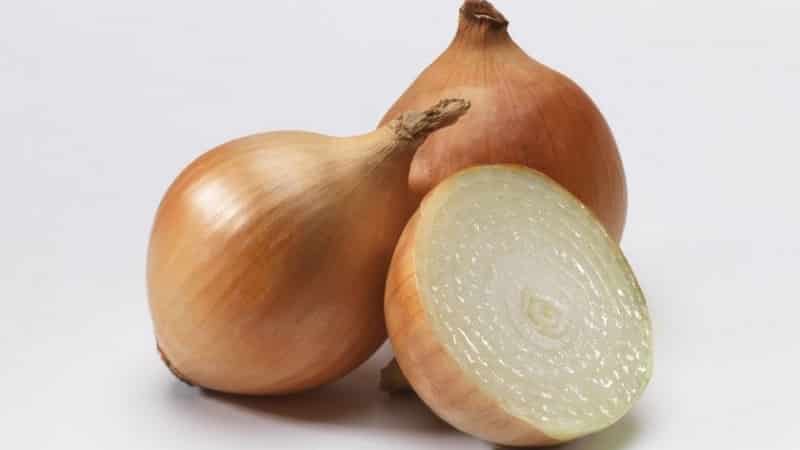
Important! Choose varieties for planting based on daylight hours. In short summers, give preference to early varieties with a minimum period of bulb ripening.
Preparation
Before winter planting sets carefully prepare the soil and seed.
beds
Choose a location for the garden bed. A well-ventilated area where snow melts early in spring and water does not stagnate is best.. Onions love loose, fertile soil with a neutral acid-base balance.
Dig up the soil with humus (5-6 kg per 1 sq. m) or mineral potassium-phosphorus fertilizers (30 g per 1 sq. m) and urea (6-12 g per 1 sq. m). Do not add unrotted manure to the ground when planting onions.
Form beds 20-40 cm high to avoid excessive moisture.
Planting material
Calibrate the seed material. Oatmeal with a diameter of up to 1 cm is only suitable for growing bulbs. Place 1 to 2 cm in size on the feather and head.
Check each onion for damage, rot, and bacterial infections. The set should be dry, without spots on the husk.
Carry out disinfection. Soak for no more than 5 minutes in a warm (+45°C) solution of copper sulfate (1 teaspoon per 1 liter of water) or potassium permanganate (10 g per 1 liter of water). Dry the planting material well for 12-24 hours.
Important! When planting in winter, do not cut off the necks of the sets. Plant it dry, without germination.
How to plant Dutch onions for the winter
To achieve good germination of seed in spring and get an excellent onion harvest, follow the following rules.
Prepare material in advance to cover the beds for the winter. For example, non-woven fabric (lutrasil, spunbond), sawdust or straw, spruce branches. The latter retain large amounts of snow on the soil.
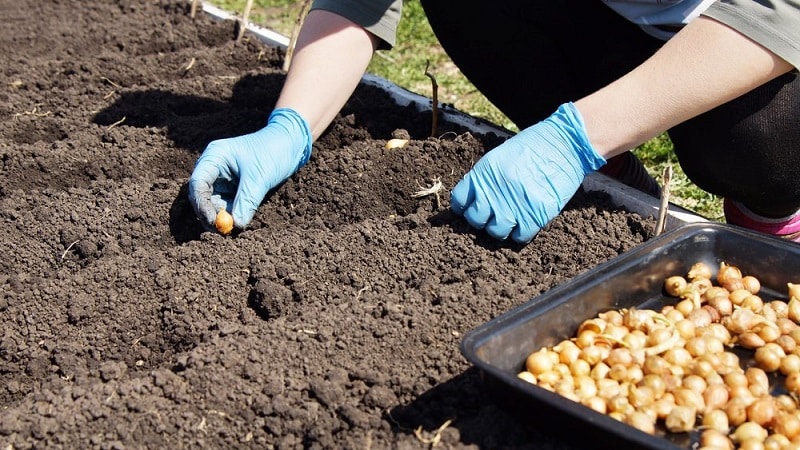
Step-by-step instruction:
- Level and compact the soil in the beds.
- Mark the rows for planting, leaving a gap of 20-25 cm between them.
- Make indentations for the bulbs in the grooves at the optimal distance from each other.
- Plant the set so that it is buried 5 cm into the soil. Sprinkle it with dry soil or peat on top.There is no need to water onions when growing them in winter.
- When the first frost occurs, cover the plantings with mulch or other prepared material.
Do not cover beds with winter onions before frost sets in. covering material - there is a risk of damping off.
Landing schemes
The gardener determines the planting scheme for seedlings himself, focusing on geometric dimensions of the beds.
Usually a tape scheme is used. There is a gap of 20-25 cm between the rows, and 5-10 cm between the onions in the rows, depending on the varietal characteristics of the mature onion head, as well as on the size of the set. Oatmeal is planted every 5-6 cm, seedlings - every 7-10 cm. Planting depth for the winter is 5 cm from the neck of the bulb to the soil surface.
Nest planting is also practiced. 3-4 bulbs are placed in one hole at a distance of 10 cm from each other.
What mistakes should you avoid?
When growing Dutch onions, consider the following nuances::
- Planting too early will lead to the emergence of seedlings and subsequent death of the onion from winter cold.
- Do not plant seedlings in a newly prepared bed. Allow the soil to settle for 2-3 weeks (less in rainy weather). Planting material in loose soil may become too deep, and seedlings will not appear in the spring for a long time.
- If you plant the seedlings shallowly, the bulbs will die from frost in winter.
- Don't forget to cover the bed with the planted onions for the winter. If there is little snow, this will help avoid freezing of the seed.
- In case of a winter with little snow or severe frosts, cover the beds with snow for additional protection.
Further care
in spring after the snow melts and the onset of warm days Without frost, the covering material is removed, and the mulch is also removed from the garden bed.If this is not done, the ground will take a long time to thaw and the growth of the onion will slow down.
When shoots appear the soil is loosened. To avoid excessive moisture of the soil and saturate it with oxygen, sprinkle it with ash.
Subsequently, fertilizing is carried out solutions of organic (chicken manure, mullein) or mineral fertilizers, regularly weed and loosen.
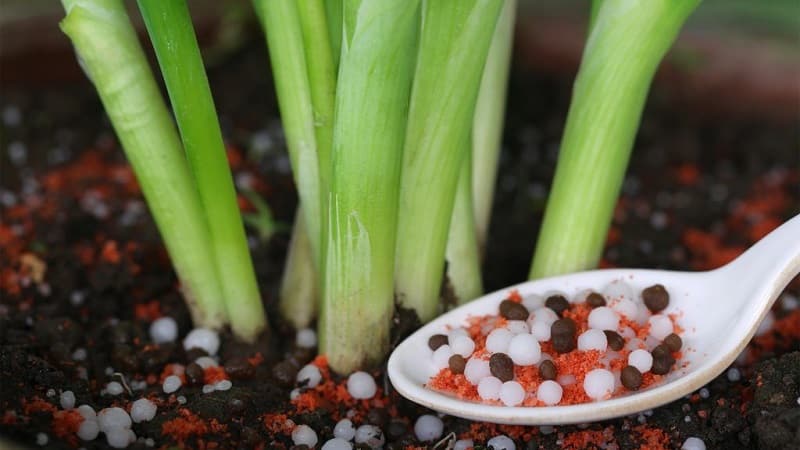
Features of planting and growing depending on the region
All of the above varieties of Dutch selection are suitable for winter cultivation in any climatic regions of Russia.
The difference lies in the timing of winter planting, which is determined by the period of frost:
- Ural winters are cold and snowyTherefore, frost-resistant early varieties are used for cultivation. Planting takes place at the end of September or beginning of October.
- In Siberia, winter onions are planted during September. Select a frost-resistant variety and carefully cover the beds for the winter.
- Gardeners of the northwestern regions Planting winter onions usually begins in the first ten days of October.
- In the central part of Russia - from September 20 to October 20.
- In the southern regions The favorable period is from the end of October to the end of November.
Advice from experienced summer residents
To reap a rich harvest of Dutch onions, follow the advice of experienced gardeners:
- If you feel that you don’t have time to plant onions, and according to the forecast frosts will come soon, postpone planting until the spring. There is a high risk that onions that have not taken root in time will freeze in winter and you will lose your entire harvest. You can only plant wild wild oats, which are poorly stored, unlike sets.
- Plant a selection between the rows of seedlings. In the spring it will produce good feathers and you will get early green onions.
- Sometimes gardeners forget what crops they grew in their garden beds in previous years. And this is important for organizing competent crop rotation. Keep a gardening diary. Draw a site plan and mark by year on which plots of land this or that crop was grown. Write down what fertilizing was done; Comment on what plant diseases or pests you have encountered.
Conclusion
Almost all varieties of Dutch sharp and semi-sharp onions are planted before winter. In regions with cold winters, the most frost-resistant ones are chosen. Such characteristics of the variety as ripening time and keeping quality are taken into account.
When planting before winter, covering materials or mulch are used, and in winters with little snow or severe frosts, they are additionally insulated with snow.